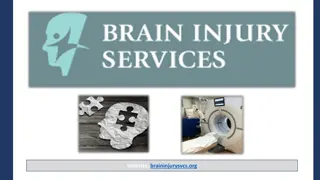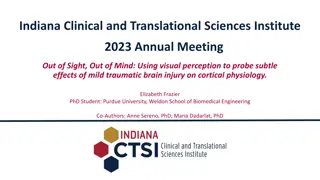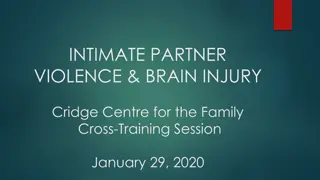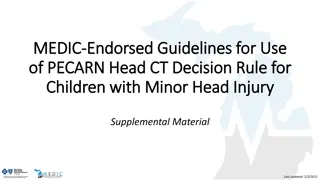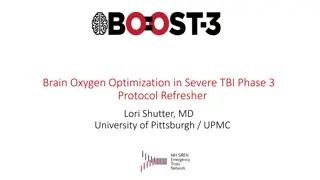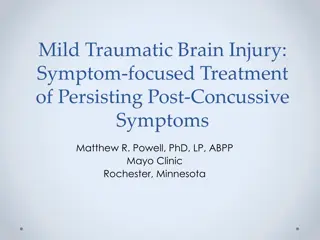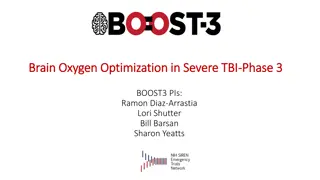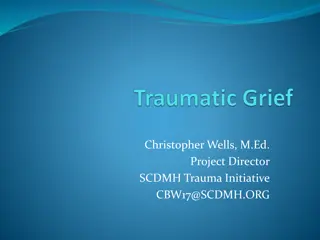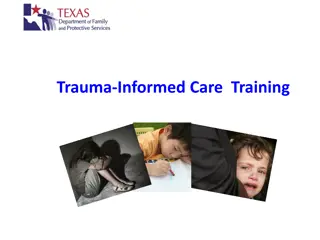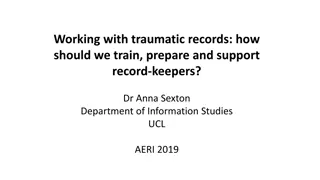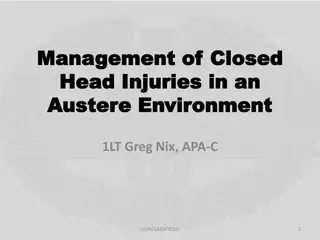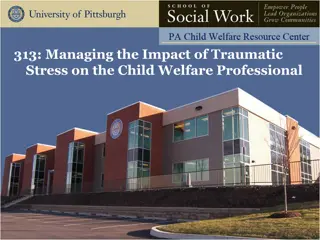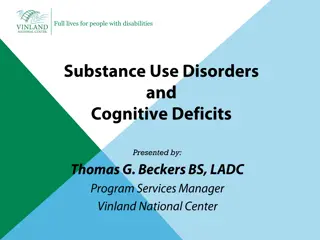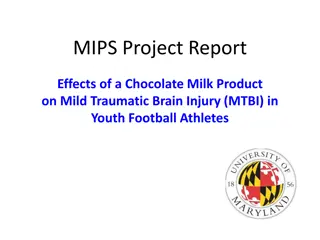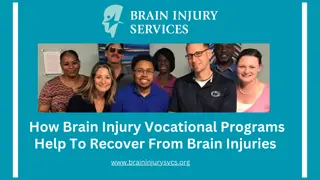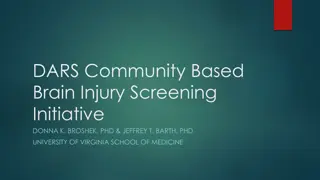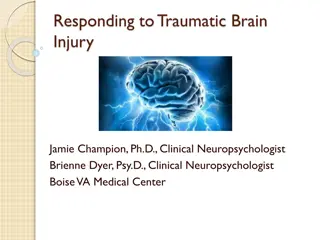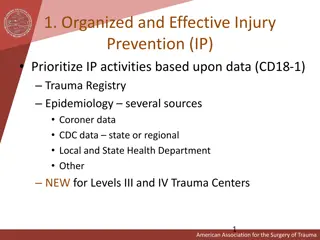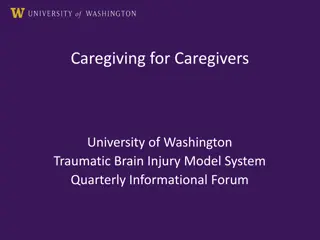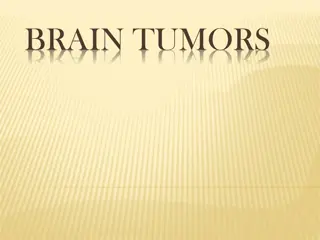Understanding Prognosis in Traumatic Brain Injury
Prognosis in traumatic brain injury is influenced by various factors such as population characteristics, impairment levels, and time frames. Predicting short-term and long-term outcomes is crucial for effective patient care, financial planning, and resource utilization. Common outcome measures include mortality rates, Glasgow Outcome Scale, Disability Rating Scale, Functional Independence Measure, and return to work assessments.
Download Presentation

Please find below an Image/Link to download the presentation.
The content on the website is provided AS IS for your information and personal use only. It may not be sold, licensed, or shared on other websites without obtaining consent from the author. Download presentation by click this link. If you encounter any issues during the download, it is possible that the publisher has removed the file from their server.
E N D
Presentation Transcript
PROGNOSIS IN TRAUMATIC BRAIN INJURY William C. Walker, MD Ernst & Helga Prosser Professor VCU Dept PM&R 10/25/23
Besides injury factors and patient characteristics, PROGNOSIS depends on: Population considered All cases Hospitalized only Acute rehab admissions only Other Outcome being measured Impairment (organ level) Functional (person level) Participation (person Satisfaction Global society) Time frame Short term Long term
Why Predict Short-Term Outcome? Inpatient Rehabilitation is expensive ($500-1500/day); patients receiving it should have a realistic chance of returning home Choosing the most appropriate setting for each patient requires a best guess of outcome The patient, family, and rehabilitation team need an estimate of LOS and D/C goals as well as needs for aftercare planning
Why Predict Long-Term Outcome? Financial planning Disability planning Long-term support system needs Resource utilization planning
Outcomes of interest across care continuum Acute Care Setting Mortality Disposition: Rehab vs SNF vs other Consciousness Complications: Sz, HC, herniation, elevated ICP, etc Long Term; additional outcomes Employment Other participation (eg. Driving) IADLS/supervision needs Satisfaction Global Inpatient Rehab Setting (post-acute) Impairment Motor/balance or other focal neuro deficit Cognitive/behavioral (TBI s signature impairment; RLAS describes pattern of recovery for severe TBI) Functional Mobility/self-care Functional cognition/communication Disposition Community vs Facility ELOS and degree of assist
Rancho Los Amigos Scale (RLAS) stages of cognitive- behavioral impairment recovery after severe TBI Coma I. Vegetative II. Minimally responsive (localizes, Not consistently FOC) III. Agitated, Confused IV. Confused, Inappropriate V. Confused, Appropriate VI. VII. Automatic VIII. Purposeful, Stand by Assist (SBA) Purposeful, SBA on Request IX. Purposeful, Modified Independent X.
TBI; What Outcome Measures are common in literature? Mortality Glasgow outcome scale (GOS) (disability + handicap) GOS extended (GOSE) Disability rating scale (DRS) (disability + handicap + impairment) Functional independence measure (FIM) (disability) Return to work (handicap/participation) Cognitive skills (impairment) Measurement modes: Screening versus brief versus comprehensive (later typically done by neuropsychologists)
General Limitations of most Outcome Measures Domain specific Floor and ceiling effects Social biases Minority, age, and gender related differences Modes of administration
Glasgow Outcome Scale (GOS) GOS Level Brief Description Widely used in trauma and neurosurgical literature as global outcome measure N/A Dead Condition of unawareness with only reflex responses but with periods of spontaneous eye opening. Dependent for daily support for mental and/or physical disability. Some disability but able to look after themselves; Independent at home but dependent outside. Resumption of normal life with the capacity to work even if pre-injury status has not been achieved; May have minor neurological or psychological deficits. Vegetative State 5 broad categories (limited sensitivity but easy to translate clinically) Levels relevant for patients admitted to IRF with severe TBI Severe Disability Moderate Disability GOSE subdivides SD, MD and GR (added sensitivity for clinical trials research) Good Recovery
Disability Rating Scale (DRS) Measures general global outcome Developed in severe TBI patients Aims to reflect functionally significant changes over entire spectrum of time (coma to community) Contains measures of impairment (GCS items), disability (cognitive ability for ADLs) and handicap/participation (overall level of life function and employability)
Types of factors used for TBI outcome prediction Demographics Injury characteristics Other clinical features (e.g. comorbidities) Radiologic and electrophysiologic data Influence of Interventions: Rehabilitative Surgical Pharmacologic
Injury characteristics; TBI Severity Categories Mild Moderate Severe Initial GCS 13-15 9-12 <9 LOC duration < 30 min - 24 hrs >24hr PTA duration < 24 hr 1-7 days >7d Imaging (CT) Normal + or - + or - Notes: Head CT diagnosis utility: Abnormal r/out mild (r/in mod vs severe) Normal does NOT r/out severe TBI If criteria have differing categories then use most severe unless clearly confounded by external factor
Injury Characteristics-Severity-Glasgow Coma Scale Injury severity via GCS helps predicts mortality as well as 3, 6, & 12 month outcome (work, global, neurobehavioral) Glasgow-Liege Scale (GCS + brainstem reflex) also predictive Long-term predictive influence very weak compared to other severity measures Main advantage is offers earlier prognostication The best motor GCS and the best overall GCS within the first 24 hours is considered to be the best acute predictor of TBI outcome
What are specific limitations of early GCS? Validity not well studied Timing variability post-injury (e.g. a mild TBI can be comatose up to 30 min) Predictability weakens progressively for longer horizons Accuracy concerns; especially if intubated Inappropriate for: Young children Severe facial injuries Under heavy influence of ETOH or drugs
Far Better TBI Injury Severity Measures as predictors of long-term outcome Length of coma TBIMS surrogate measure is time to follow commands (TTFC) Predictive of GOS, cognitive skills, RTW proportionate relationship to outcome Length of post-traumatic amnesia (PTA): Time to regain continuous memory of ongoing events Prospective: PTA = < 75 on GOAT or >24 on O-Log; Other; Aphasia caveats Retrospective: oriented x 3, recalled memory gap with anchors Predictive of GOS, cognitive skills, RTW Proportionate relationship Single best predictor of outcome in TBI
TBI Length of Unresponsiveness; Caveats Predictability stronger than GCS but weaker than PTA duration When emerge from coma < 3 weeks, > 50% regain independence in self- care For emerging consciousness TBI group, when still in coma or vegetative at 4 weeks: > 50% regain consciousness Up to 44 % reach at least moderate disability on GOS 70% return to home by 2 years Chance of Good Recovery on GOS very low
PTA = Anterograde Amnesia after TBI Term popularized by Russell & Smith 1961. PTA is the period of time from the point of injury until the individual has a continuous memory for ongoing events (Whyte & Rosenthal, 1988). The patient just emerged from PTA remembers today what happened yesterday and does not begin each day with a blank mind (Jennett & Teasdale 1981). Also has been described as post-TBI confusional state, a form of delirium 17
DAI: Phase Time Relation Cognitive Impairment c/w baseline PTA duration coma confused cognitive restoration
Walker WC, Ketchum JM, Marwitz JH, Chen T, Hammond F, Sherer M, Meythaler J. A multicentre study on the clinical utility of post-traumatic amnesia duration in predicting global outcome after moderate-severe traumatic brain injury. J Neurol Neurosurg Psychiatry 2010;81:87-89.
Walker WC, Stromberg KA, Marwitz JH, Sima AP, Agyemang AA, Graham KM, Harrison-Felix C, Hoffman JM, Brown AW, Kreutzer JS, Merchant R. Predicting long-term global outcome after traumatic brain injury: Development of a practical prognostic tool using the TBI Model Systems National Database. J Neurotrauma 2018;35(14):1587-1595. doi: 10.1089/neu.2017.5359. Overall Results: Overall Results: Improvement in GOS levels over outcome years 100 Severe Disability 31.8% at 1-year post-injury 26.9% at 2-year 21.8% at 5-year 90 80 70 60 50 40 Good Recovery 35.9% at 1-year post-injury 39.5% at 2-year 42.0% at 5-year 30 20 10 0 Year 1 Year 2 Year 5 Severe Disability Moderate Disability Good Recovery 20
Year Year- -2 GOS Prediction Tree 2 GOS Prediction Tree 21
Findings Pattern Summary Injury Characteristics PTA duration consistently dominated branching hierarchy Not contributory: initial motor GCS, focal hemorrhagic mass lesion on head CT, elevated ICP, cranial surgery, and acute hospital LOS Sociodemographic Characteristics Age was generally the leading secondary predictor (after PTA) Other contributors: premorbid education, productivity, & occupation Not Contributory: sex, premorbid alcohol/drug misuse 22
PTA duration top predictor Reinforces past TBI outcome prediction research Groups with shortest PTA duration (best prognosis): Upper cut-point increased from 16 days at year-1, to 18 days at year-2, to 20 days at year-5 GOS improved sequentially Highest Good Recovery rate in any prognostic group is 65.7% Groups with longest PTA (worse prognosis): Lack of branching suggests a PTA duration threshold beyond which the TBI is so severe that it negates any secondary predictor influences; our data indicates this threshold is around 7 weeks.
PTA duration thresholds for Long Term GOS Very unlikely to have Severe Disability (SD) PTA duration < 3 wks if not elderly At 2yrs 5.8% SD for Age < 37; 31.8% SD for Age > 58 Very unlikely to reach Good Recovery (GR) PTA duration > 7-8 wks At 2 yrs 1 in 8 reach GR Data suggests the following meaningful Severe TBI subcategories: 1-3 wks PTA = Severe TBI 3-7 wks PTA = Very Severe TBI > 7 wks PTA = Extremely Severe TBI
TBI Global Outcome Predictors: Other Injury Characteristics Type: Penetrating vs Closed Walker WC, Ketchum JS, Marwitz JH, et al. Global Outcome and Late Seizures after Penetrating versus Closed Traumatic Brain Injury (TBI): A NIDRR TBI Model Systems Study. J Head Trauma Rehabil 2015;30(4):231-240. Hemiparesis, other focal neuro deficit (PTA duration does not well capture focal injury) Brainstem reflexes predict 3, 6, 12 month (work and function) Intracranial Pressure (GOS, mortality; secondary injury marker) > 20 mm Hg sustained worse outcome > 40 mm Hg worse outcome Medical Comorbidites (Acute care LOS often indicative) including concurrent traumatic stroke Jenkins RM, Manche NL, Sima AP, Marwitz JH, Walker WC. Characterizing Comorbid Cerebrovascular Insults among Patients with TBI at a TBI Model Systems Rehabilitation Center . J Head Trauma Rehabil 2020 Jan/Feb;35(1):E51-E59. Note: Etiology of TBI not shown as predictor except GSW as marker for penetrating TBI
TBI outcome predictors: Patient background characteristics associated with poorer outcomes Higher Age (adult population): #2 most important predictor after PTA duration Pediatric population note: Some studies show worse outcomes for < 4 yo. Also, cognitive or behavioral issues may not be evident post-acutely until that time, developmentally, that child would reach certain milestones; as the child grows and their brain develops, problems may emerge Less Education Unemployment and lower skilled occupations (especially for RTW prognosis) Prior TBI Prior psychiatric history Female (mild TBI only)
TBI Predictors: Functional Measures DRS at rehab admission and FIM at rehab admission correlates with discharge status and RTW at one year
Other Severe TBI Thresholds Good long-term GOS unlikely for all severe TBI with any of these features: Penetrating type Also higher risk for posttraumatic epilepsy, persistent focal neurologic deficits (e.g. hemiparesis) Age > 65 Bilateral brainstem abnl on imaging
TBI predictors: Radiologic Correlates Intracranial masses Cerebral contusions Subdural worse than epidural hematoma Midline shift > 10 mm Brainstem lesions Limited additional variance beyond PTA duration and age for long-term outcomes
Stromberg KA, Graham KM, Agyemang AA, Walker WC, et al. Using Decision Tree Methodology to Predict Employment after Moderate to Severe Traumatic Brain Injury. J Head Trauma Rehabil 2019 May/Jun;34(3):E64-E74. Overall Results: Overall Results: Employed ( 45 40 35 30 Year 1 = 33.6% Year 2 = 37.5% Year 5 = 40.6% 25 20 15 10 5 0 Year 1 Year 2 Year 5 Training Set Test Set 30
Summary from our employment study PTA duration was primary predictor of employment Nearly half of participants with less than 3 weeks of PTA duration employed at each follow up year PTA duration of 3- to 4-weeks appears to be a critical demarcation between good employment prognoses and significant challenges Group with longest PTA duration showed increasing rates of employment Year 1: 17% Year 2: 20.8% Year 5: 29.4% 70% of individuals who spent more than 4 weeks in PTA remain unemployed at year 5 Similar to unemployment rates of individuals with disabilities in the US (65%) Secondary Predictors: Yr 1: Pre-injury Occupation Yr 2: Pre-injury Employment, Education level Yr 5: Education level 31
Other factors for guiding return to work (RTW) after TBI Other factors for guiding return to work (RTW) after TBI Assessment of emotional and behavioral functioning is important Assessment of cognitive functioning is important Much depends on the demands of the individual s specific job, employer attitude/accommodation, work history Other factors include financial needs/incentives of work versus disability and retirement age factors 32
Return to Driving: determinates and predictors Cognitive skills: Executive function, Attention, Memory Visual-perceptual motor skills Seizure history Premorbid driving experience and skills (i.e. crash & moving violation history) Resources (financial, other SDOH)
Prognosis in Mild TBI? ER samples Predictors of postconcussion symptoms (PCS): cognitive testing, female, MVA (vs athletic), LOC duration, event related stress, psych hx, severity of event pain, education LOC +/- not predictive of neuropsych testing impairments Athlete and Military samples Predictors of early PCS: retrograde amnesia, PTA NOT predictive: on field LOC Predictors of Persistent PCS Early symptom severity, Mental health history, prior mild TBIs, Female gender, comorbidities, litigation & work comp, emerging evidence on blast mechanism
Repetitive mild TBI may have unique poorer outcomes Research findings are not conclusive, but Linked to evidence for chronic traumatic encephalopathy (CTE), or dementia pugilistica and can result in extrapyramidal symptoms and pathology similar to Alzheimer's. Anecdotal reports of repeat mild TBI before last mild TBI fully recovers (Second impact syndrome results from inability to autoregulate blood pressure after repeat concussion; this hypertensive emergency has resulted in death (in those younger than 18).
Definition of Mild TBI A disruption of brain function resulting from a traumatic force to the head or brain Indicated by new onset of at least one of the following: Loss of consciousness (LOC) < 30 min Post-traumatic amnesia (PTA) < 24 hr Loss of memory for events immediately after (+/- before) injury Alteration of consciousness (AOC) Change in mental status at the time of injury such as confused, disoriented, or dazed Neurological deficits that may or may not be temporary Seizure, weakness, loss of balance, paralysis etc
Mild TBI diagnosis Must Have: Evidence of immediate AOC MSE during AOC window c/w AOC (or seizure) Patient Interview after AOC window Witness corroborated LOC (or seizure) Memory gap pattern c/w TBI physiology AOC symptoms c/w TBI physiology Least specific Dazed Walker WC, Cifu DX, Hudak A, Goldberg G, Kunz RD, Sima A. Structured interview for mild traumatic brain injury after military blast: inter-rater agreement and development of a diagnostic algorithm. J Neurotrauma 2015;32(7):464-73. Confused Saw Stars Most specific
APPENDIX TBI prognosis versus other acquired Brain Injury conditions GOS classification trees; Walker WC et al 2018
Prognosis in Acquired Brain Injury Long Term; additional outcomes Employment Other participation (eg. Driving) IADLS/supervision needs Satisfaction Global Acute Care Setting Mortality Disposition: Rehab vs SNF vs other Consciousness Complications: Sz, HC, herniation, elevated ICP, etc Inpatient Rehab Setting Impairment Motor Cognitive/behavioral/communication Functional Motor Cognitive Disposition Community vs Facility ELOS Natural Recovery Plasticity Exercise Other? Remediation Effort ADL-mobility training Adaptation External aids Other? Compensatory Social Supports
Brain Injury Prognosis; Diffuse vs Focal injury Diagnostic Category Prevailing Impairment Time until Max Closed TBI (DAI esp) Cognitive-Behavioral Several Years SAH Cognitive-Behavioral Several Months Anoxic BI Cognitive-Behavioral Several Months Stroke, Ischemic Focal Neuro deficit Several Months Stroke, Hemorrhagic Cognitive-Behavioral + Focal Neuro deficit Several Months Complex TBI (penetrating, DAI c/b traumatic stroke) Cognitive-Behavioral + Focal Neuro deficit Mixed
Other Diffuse Brain Injury conditions Hypoxic SAH Similar to TBI, good physical outcomes can have residual cognitive, behavioral & social difficulties Prognosis TBI > SAH > Hypoxic
Hypoxic/Ischemic BI Often seen in conjunction with severe TBI What brain regions are more susceptible to hypoxic injury? Hippocampus Basal Ganglia Cerebellum Outer Cortex Layer Boundary zone injuries usually related to perfusion failure with injury confined to overlap territories of major cerebral
Subarachnoid Hemorrhage Ruptured aneurysm cause in 70-90% Aneurysms usually located at circle of Willis involving AntCommArt, MCA trifurcation, Carotid, & PostCommArt 40-45% die in first month Many will have intracerebral component (infarct or hemorrhage)
Year Year- -1 GOS Prediction Tree 1 GOS Prediction Tree 44
Year Year- -2 GOS Prediction Tree 2 GOS Prediction Tree 45
Year Year- -5 GOS Prediction Tree 5 GOS Prediction Tree 46









